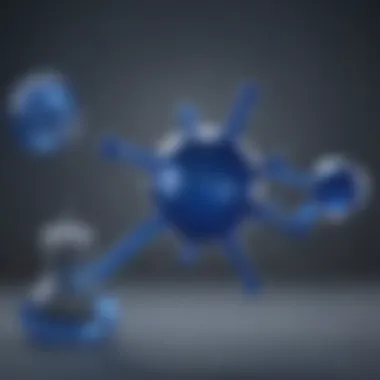Methylene Blue: Applications and Implications in Science


Intro
Methylene blue, a compound with a storied past, holds a myriad of applications that bridge several scientific disciplines. From its initial use as a dye in the late 19th century to its contemporary role in medicine and environmental science, this chemical has shown remarkable versatility. Not only does it engage the imagination of researchers across the globe, but it also raises important questions about its efficacy and safety.
As we peel back the layers of methylene blue, we find it intertwined with significant advances in biological research, therapeutic modalities, and environmental studies. The article is organized to provide a thorough exploration of these themes, delivering insights into both its benefits and limitations.
In doing so, readers will encounter key discussions, including the historical significance of methylene blue, its chemical attributes, and the implications of its diverse applications. Furthermore, we will shed light on future research directions that may influence its usage moving forward. This excursion aims not only to educate but also to inspire curiosity about this multifaceted compound.
"Methylene blue stands at the crossroads of science and medicine, serving as a testament to the innovative spirit of the research community."
With a solid framework in place, let’s dive in to understand the methodologies employed in studying methylene blue, its applications, and the future paths it may unveil.
Prologue to Methylene Blue
Methylene blue, a compound initially known for its vivid blue color, plays an intriguing role across a variety of scientific fields. This section serves as a gateway to understanding this compound's significance in both historical and modern contexts. Not only is it important in biological research, but it also finds applications in environmental science and medicine. As we journey further, a closer examination of its properties and implications reveals just how essential methylene blue is to scientific advancement.
Definition and Chemical Structure
Methylene blue is an organic dye with the molecular formula C168ClN3S. With its distinct blue hue, it belongs to a class of compounds called thiazine dyes. The chemical structure comprises a complex arrangement of carbon, hydrogen, nitrogen, chlorine, and sulfur atoms, illustrating its multifaceted nature. This intricate structure is responsible for its unique biochemical interactions. In essence, methylene blue can be viewed as a window into various biological processes, acting not just as a dye but also as a reactive agent in numerous biochemical assays.
Historical Context and Discovery
The discovery of methylene blue dates back to the 19th century, around 1876, when it was synthesized by Heinrich Caro. Originally intended as a textile dye, it soon caught the attention of the medical community. Early on, it was used in the treatment of various ailments, including malaria. This illustrates a key point: what began as a coloring agent evolved into a vital medical tool, underscoring the dynamic relationship between discovery and application in science. As new research surfaces, it highlights the ongoing cultural and scientific relevance of methylene blue, which extends beyond mere historical interest into the realms of current medical practices and environmental considerations.
Methylene blue's journey from a dye to a medicinal agent showcases the fluid boundaries of modern science, where one discovery can lead to another unforeseen application.
Chemical Properties of Methylene Blue
Understanding the chemical properties of methylene blue is fundamental, not just for its applications, but also for grasping how this dye interacts with various biological and environmental systems. Methylene blue, with its unique structural qualities, serves as a potent tool across numerous scientific fields. This section will delve into its molecular characteristics and its solubility and stability, which are key factors that inform its diverse applications and implications.
Molecular Characteristics
Methylene blue is classified as a synthetic dye belonging to the phenothiazine family. The molecular formula, C168N3S, clearly indicates the complexity of its structure, which comprises a thiazine ring that is vital for its biological activity. Once it enters the bloodstream or any fluid medium, methylene blue can easily undergo reduction, forming leucomethylene blue, a colorless derivative.
This reversible transformation is of particular significance in many of its clinical applications. For example, when used in medical diagnostics, the reduced form can enhance the contrast in imaging techniques, providing clearer visual cues. Moreover, its ability to interact with various cellular components stems from its positive charge under physiological conditions, making it readily absorbed by negatively charged cell membranes. This characteristic is not only key for its application in cellular imaging but also crucial for understanding how it combats harmful pathogens. In essence, the molecular dynamics of methylene blue can dictate its utility, making it a valuable asset in medical and environmental research alike.
Solubility and Stability


Solubility is another critical chemical property that directly impacts the usability of methylene blue in different contexts. At room temperature, methylene blue is soluble in water, promoting its efficient dispersion in biological and environmental samples. This feature allows for easy administration in medical procedures, where rapid distribution is often necessary for effective diagnostics or treatment.
However, the stability of methylene blue in solution can vary based on several factors, including pH and light exposure. In acidic conditions, the compound remains stable, but it can degrade under heavy illumination or prolonged storage. As such, careful handling and optimal storage conditions are essential to maintain its efficacy. Considerations about solubility and stability are paramount, especially in research labs where experiments depend on precise chemical integrity.
"Chemical stability and solubility are paramount for the effective application of compounds in both clinical settings and environmental research."
To summarize, the chemical properties of methylene blue provide insight into its behavior and potential applications. Recognizing its molecular characteristics and the nuances of its solubility and stability is crucial for students, researchers, and professionals engaged in various scientific explorations.
Biomedical Applications
The significance of biomedical applications of methylene blue cannot be overstated. This compound has carved its niche not just in laboratory settings, but also in broader medical practices. Its versatility extends across diagnostic procedures and therapeutic uses. Understanding its medical implications reveals not only its benefits but also the careful considerations that come along with its use.
Role in Diagnostic Procedures
Methylene blue has an established place in various diagnostic procedures, making it an invaluable tool in the medical field. Its ability to stain tissues and cells provides essential contrast in imaging techniques.
Use in Staining Protocols
The use of methylene blue in staining protocols is particularly noteworthy. Its vibrant color allows for easy differentiation of cellular components under a microscope. Most notably, it highlights nuclei in cells, making it easier to identify abnormalities. This characteristic plays a critical role in histopathology, pathology studies, and various microscopic evaluations. One of the unique features of using methylene blue in staining is its compatibility with multiple biological tissues, making it a popular choice among researchers and labs. However, it's essential to recognize its limitations; over-saturation can lead to misleading results and hinder the clarity of visuals. Thus, the precise application is crucial for effective use.
Tracing Cellular Processes
Another critical application of methylene blue lies in its ability to trace cellular processes. This compound serves an important role in tracking cellular mechanisms during research studies, providing real-time observations of cellular function. Its key property of penetrating cells and being observable through fluorescence makes it suitable for in vivo studies. This unique feature allows researchers to monitor the progression of cellular activities, particularly in studies related to cell metabolism. However, the challenge arises with its interaction with certain biomolecules, which can impede accurate tracing results. Researchers must meticulously assess the context in which it is used to avoid potential interference with their findings.
Therapeutic Potential
Methylene blue’s therapeutic potential stretches beyond diagnostics, offering promise in treatment scenarios as well. It has garnered attention for its microbiological and neurological applications, making it a compound worth exploring in more depth.
Antimicrobial Properties
The antimicrobial properties of methylene blue present a fascinating element within its therapeutic potential. Historically, its use has been recognized in treating infections, particularly those caused by certain bacteria. Its ability to disrupt bacterial cell walls underpins its effectiveness against several pathogens. The antimicrobial characteristic is a beneficial aspect, as it lends itself well to formulations intended for treating skin infections and even some forms of malaria. Nonetheless, while the advantages are clear, one must also consider the potential for resistance development. Overreliance on methylene blue in clinical scenarios could lead to reduced efficacy over time; hence, judicious use is recommended to maximize its benefits without fostering resistance.
Neuroprotective Effects
Beyond its role in microbial treatment, methylene blue shows potential neuroprotective effects. This characteristic has implications for managing neurodegenerative diseases and conditions such as Alzheimer's and Parkinson's. It functions by improving mitochondrial function and reducing oxidative stress within neurons, offering a protective mechanism against cell death. Its neuroprotective properties and overall enhancement of cognitive function make it a promising agent for future developments in therapeutic strategies. However, the unique feature here is the dose-response relationship which appears to be quite sensitive. Ensuring the right dosage is pivotal, as both under-dosing and overdosing can either diminish its efficacy or trigger adverse reactions.
In summary, the biomedical applications of methylene blue provide a glimpse into its remarkable versatility and potential within medical science. Though there are clear benefits, understanding the nuanced challenges and limitations associated with its use suggests that it warrants careful consideration in both diagnostics and therapeutic contexts.
Methylene Blue in Environmental Science


Methylene blue serves an essential role in environmental science, particularly due to its unique properties and versatile applications that extend into both aquatic systems and wastewater management. By having a clear grasp of these areas, we gain a fuller comprehension of the environmental implications and benefits of this compound in various scientific studies. Its usability in investigating ecosystem health and the treatment of polluted waterways underscores why methylene blue is not just a lab tool but a key player in environmental protection efforts.
Impact on Aquatic Systems
Methylene blue's impact on aquatic systems is multi-dimensional, producing both beneficial outcomes as well as potential drawbacks. It’s crucial to weigh these aspects when considering its applications.
Toxicological Effects on Marine Life
When used in aquatic environments, methylene blue can demonstrate toxicological effects on marine species. While it is helpful in assessing the health of marine ecosystems, it can also induce harmful reactions in sensitive organisms like fish and invertebrates. The key characteristic concerning the toxicological effects of methylene blue is its ability to interfere with the respiratory functions of these marine lifeforms, potentially leading to distress or mortality in vulnerable populations. This becomes a significant consideration when it comes to utilizing the dye in field studies.
On the flip side, understanding these toxicological responses can inform researchers and policymakers about safe thresholds, ensuring responsible usage of methylene blue while conducting environmental assessments. However, continuous monitoring and further research are needed to ensure that environmental applications of methylene blue don’t harm the very ecosystems being studied.
"Understanding how methylene blue affects marine life is pivotal. It helps us balance scientific curiosity with ecological well-being."
Role as a Marker in Environmental Studies
Methylene blue has gained recognition as a valuable marker in environmental studies, particularly for tracing contaminants in aquatic systems. Its vibrant hue enables researchers to easily monitor water quality and explore how substances disperse in the environment. A major advantage of using methylene blue is that it can serve as an indicator of certain chemical interactions and changes in water properties, which is beneficial for understanding flow patterns and pollutant breakdown processes.
Nevertheless, the dye's striking color and chemical stability can be a double-edged sword. While it effectively reveals details about the contamination levels, it can also affect visibility and the ecosystem's balance if left unchecked. Thus, researchers must take care to utilize methylene blue judiciously to mitigate any potential negative ramifications on aquatic ecosystems.
Wastewater Treatment Applications
The application of methylene blue in wastewater treatment has garnered increasing attention. It can play a role in the analysis of effluents, helping to determine the efficiency of various treatment methods. When used as a tracer in controlled experiments, methylene blue aids in identifying and optimizing filtration and detoxification processes within treatment systems. Its strong yet manageable chemical properties allow it to be a reliable tool for evaluating how well particular systems manage waste.
With the ongoing concerns regarding water pollution, the need for effective monitoring techniques is more pressing than ever. Methylene blue’s incorporation into treatment evaluations allows for improved strategies that directly contribute to bettering water quality and, consequently, ecological health. Thus, its importance in the environmental sector continues to grow as both awareness and technology evolve.
Methylene Blue in Research Innovations
Methylene blue is not just a compound with a storied past; its future in research is equally compelling. As researchers delve into its various applications, the focus increasingly shifts to how this compound can contribute to innovative technologies and methodologies in scientific investigation. This section highlights the significant advancements linked to methylene blue, particularly in the realms of cellular imaging and drug development. By understanding its transformative role, we appreciate its value in pushing the boundaries of current research.
Advances in Cellular Imaging
In cellular biology, visualization of processes at the cellular level is crucial. Methylene blue plays a pivotal role in cellular imaging, providing researchers with a valuable tool for observing complex biological systems.
- Fluorescent Properties: Methylene blue possesses distinct fluorescent properties, which enable it to emit light when exposed to particular wavelengths. This attribute is essential for enhancing the visibility of cells and tissues during imaging techniques such as fluorescence microscopy.
- Live Cell Imaging: What sets methylene blue apart is its efficacy in live cell imaging. The ability to track cellular dynamics in real-time provides insights that might otherwise be inaccessible. For instance, by labeling cells with methylene blue, scientists can observe behavior changes under stimuli without harming the cells.
- Staining Techniques: Its utility extends to various staining protocols used in histology. Methylene blue is often employed to selectively stain living or dead cells, which aids in distinguishing cell viability during experiments. This is particularly crucial in developmental biology or cancer research where understanding cell fate is essential.
Methylene blue’s adaptability in imaging processes provides an unprecedented opportunity for researchers aiming to gain a nuanced understanding of cellular interactions and functions.


Potential in Drug Development
The journey of drug discovery is longer and often fraught with challenges. Methylene blue has emerged as a promising candidate in this field, offering potential pathways to novel therapeutic solutions.
- Drug Repurposing: One significant area of interest lies in drug repurposing efforts. Historically, methylene blue has been used as a treatment for various ailments, including malaria. However, recent studies suggest that it could also play a role in treating neurodegenerative diseases like Alzheimer’s. Such repurposing showcases the potential for existing drugs to be revitalized in new contexts, saving time and costs in the development phase.
- Targeting Pathogens: Methylene blue’s antimicrobial properties have caught the attention of those studying its effect against resistant bacterial strains. Its use in formulating new therapeutic agents against infections provides a double benefit: addressing the rising issue of antibiotic resistance while also harnessing an established compound.
- Enhancing Pharmacological Interventions: Researchers are looking into how methylene blue could enhance the efficacy of other drugs. By acting synergistically with conventional therapies, it has the potential to improve patient outcomes, particularly in complex conditions requiring multifaceted treatment approaches.
Controversies and Limitations
Understanding the controversies and limitations surrounding methylene blue is crucial, especially as this compound continues to gain traction in various fields. While its applications range from medical to environmental uses, the discussions regarding its safety and regulatory challenges are equally significant. Informed use of methylene blue becomes essential not just for advancing research but also for ensuring public health and environmental sustainability.
Adverse Effects and Toxicity
The use of methylene blue isn’t without its drawbacks. There are adverse effects reported which demand careful consideration. For instance, methylene blue can cause allergic reactions in some individuals, presenting symptoms like itchiness or swelling. Moreover, at higher dose levels, methylene blue has been documented to induce serotonin syndrome, especially in patients on certain medications. This is particularly alarming since serotonin syndrome involves a potentially life-threatening condition, marked by symptoms such as confusion, rapid heart rate, and possibly seizures.
As illustrated in various studies, the therapeutic window can be rather narrow. Whether using it for therapeutic purposes or as a diagnostic agent, practitioners must balance its benefits against these possible risks. Moreover, the toxicity implications extend beyond human health—in aquatic ecosystems, methylene blue has shown harmful effects on marine life, raising alarms about its environmental footprint.
Regulatory Challenges
Navigating the regulatory challenges associated with methylene blue is like trying to swim upstream. Many scientific and medical communities champion its benefits, yet the regulatory landscape is less clear-cut. In differing jurisdictions, classifications—whether as a drug or a chemical compound—can lead to inconsistent regulations. This discrepancy can hinder research and hinder clinical applications.
In the United States, for example, methylene blue is categorized as a drug intended for specific uses, which suggests a more stringent oversight when it comes to clinical trials and applications. Conversely, in other countries, it may be viewed more generically, making it harder to monitor its safety and efficacy effectively.
Applications may vary globally, yet the core issues of toxicology and regulation remain universal.
The combination of interest in innovative uses and stringent regulations creates an enviable paradox: researchers are eager to explore, but regulatory pathways often feel like a maze. This is exacerbated by a lack of extensive clinical trial data supporting some of the emerging uses, leading to calls for comprehensive studies that can validate methylene blue's efficacy and safety across various applications.
Future Directions in Methylene Blue Research
Methylene blue has been a compound of interest since its inception, attracting attention from various sectors including medicine, environmental science, and research. Given its multifaceted nature, the future directions in methylene blue research hold great promise. From its therapeutic possibilities to environmental applications, further exploration offers potential to unlock significant benefits. This section dives into fresh avenues of research that could reveal new insights about methylene blue, prompting exciting developments that extend well beyond its current uses.
Emerging Research Areas
Interest in methylene blue isn't slowing down; rather, it's expanding into captivating new domains:
- Neurodegenerative Diseases: Researchers are looking into methylene blue's role in conditions like Alzheimer's and Parkinson’s disease. They aim to determine how it may slow progression and improve cognitive function. It has been suggested that its neuroprotective qualities could offer a novel approach to treating such complex disorders.
- Antioxidant Properties: Recent studies are beginning to explore methylene blue’s efficacy as an antioxidant. As oxidative stress is a key player in numerous diseases, identifying its mechanisms could lead to innovative treatments.
- Cancer Research: There’s a burgeoning interest in understanding methylene blue's potential in oncology. Its ability to target cancer cells selectively, using photodynamic therapy, may pave the way for effective treatment strategies without the harsh side effects commonly seen with traditional therapies.
- Infections and Antimicrobials: The rise of antibiotic resistance makes the search for new antimicrobial agents crucial. Methylene blue has shown promise in laboratory settings against various pathogens, providing a potentially effective solution when conventional methods fail.
"Exploration of methylene blue's attributes in these areas creates an engaging landscape for future research, with each potential application oozing promise for significant advancements."
Potential Role in Personalized Medicine
Personalized medicine is a burgeoning field aimed at tailoring treatments to individual patients. Methylene blue could play an essential role in this approach:
- Tailored Therapeutics: Utilizing genetic markers, researchers can assess how individuals respond to methylene blue. This can lead to customized treatment plans that maximize efficacy and minimize side effects.
- Biomarker Development: Identifying specific biomarkers associated with methylene blue’s effectiveness may allow for more precise diagnostic tools, helping clinicians make better-informed decisions tailored to each patient’s unique profile.
- Combination Therapies: Rather than a one-size-fits-all solution, researchers are investigating how methylene blue can work synergistically with other compounds. This could enhance therapeutic outcomes and provide more comprehensive care for patients suffering from complex disorders.
Continuing research in these promising areas illustrates methylene blue’s vast potential, setting the stage for significant contributions to science and medicine. As we look beyond the familiar, the unfolding narrative of methylene blue ensures it remains a pivotal player in the advancing landscape of research.







